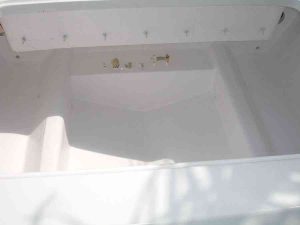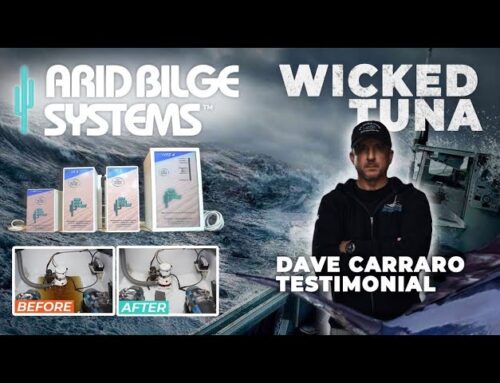J.P. Ferris has been painting boats and mega yachts throughout his 35-year career. He’s also painted aircraft, amusement park set designs, and vehicles in a factory setting. As a national brand manager with Axalta Coating Systems, he covers the Marine, Aviation, Fleet and Industrial segments, and he can often be found providing in-person consultation services to major boat builders all over the country.
I got the chance to sit down with J.P. at a recent boat show, where he was manning a table covered in colorful paint swatches. I asked him some questions about the paint and gelcoat in the bilge of a boat, and learned the following:
There are multiple types of finishes available on the market, but most fiberglass boats either have a gel coat or a Urethane coating. These coatings each have different pros and cons, but both require basic routine maintenance to stand the test of time. Maintenance is usually fairly simple if you keep in mind that marine coatings have one main enemy: standing water.
Urethane coatings are often used in bilges because it looks nice and is easy to clean, but they can react very poorly to being submerged in water for extended periods. “Urethane coatings, if left submerged, can develop blisters and begin to delaminate,” says J.P. In other words, when water permeates the surface of the urethane coating, it creates bubbles underneath the surface of the paint, which lead to flaking and peeling of the layers of paint.
When I asked him how long it would take for a fresh coat of bilge paint to begin to flake from being left submerged in bilge water, J.P. said it could take anywhere from a week to months depending on preparation, film thickness, and the time submerged. To fix it, you’d have to sand the remaining paint off, prime, and repaint, which is time-consuming and costly.
It’s best practice to keep the bilge areas dry 24/7, automatically, rather than just waiting for a deferred maintenance hassle like this one.

A freshly painted gel coat in the bilge of a boat
When it comes to gel coats, “water can permeate, but it’s a lot more stable. [Standing water] is not as big a problem [on gel coats as on urethane], but it is very unsightly,” says J.P. This is good news for those of us who are still not doing anything about the water in the bilge. But standing water will easily stain gelcoat and corrode mounted hardware and wiring. According to J.P., “the staining can get oily and ugly, and boat owners will pour degreaser, acid, and bleach down there to try to clean it up.” If you own a boat with a gelcoat bilge, which includes most smaller boats, you’re likely already aware of the staining that can happen on your gel coat.
It’s best practice to keep the bilge areas dry 24/7 so that they never stain, as it’ll simplify cleaning and maintenance and improve the resale value of the boat.
J.P. is excited about Arid Bilge Systems because of how simple it makes the maintenance tasks that support the longevity of a bilge paint job. He has a boat of his own, so he knows the struggle of keeping the bilges dry. Automating this chore can drastically reduce the chances of damage and discoloration to the paint or gelcoat. It can also help remove the accumulation of mold and mildew and can help slow and prevent the rusting and corrosion of other internal components such as the boat’s engines and generator.

Keeping the engine room dry and tidy will help maintain all components
Read another article that J.P contributed to here, where he shares his expertise with Bayliss Boatworks and discusses cutting-edge developments in marine finishes.
Check out Axalta Coatings’ work in marine coatings.



